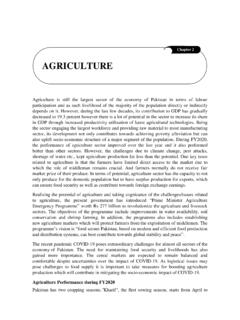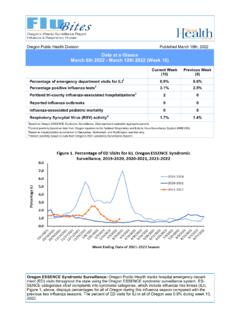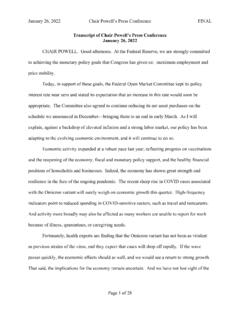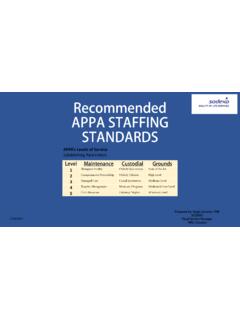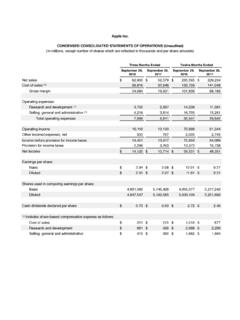Transcription of Centerfor ClinicalStandardsandQuality/Quality,Safety ...
1 Memorandum Summary CMS is committedto continuing to take critical steps to ensure America s healthcare facilities are prepared to respond to the Coronavirus Disease 2019 (COVID-19) PublicHealth Emergency (PHE). Visitation Guidance:CMS is issuing new guidance for visitation inICF/IIDs and PRTF sduringthe COVID-19 PHE. The guidance below providesways anICF/IID and PRTF canmore safely facilitate in-person visitationandaddress the psychosocial needs ofclients/residents. Coordination with the Centers for Disease Control and Prevention (CDC)and public health departments-We encourage all ICF/IIDs and PRTFs tomonitor the CDC website for information and resources and contact their healthdepartment when needed (CDC Resources for Health CareFacilities:Management of Visitors to Healthcare Facilities in the Context of COVID-19:Non-US Healthcare Settings | CDC)DEPARTMENT OF HEALTH & HUMAN SERVICES Centers for Medicare & Medicaid Services 7500 Security Boulevard, Mail Stop C2-21-16 Baltimore, Maryland 21244-1850 CenterforClinicalStandardsandQuality/Qua lity,Safety& Oversight Group Ref: QSO-21-14-ICF/IID & PRTF DATE: February 10, 2021 TO: State Survey Agency Directors FROM: Director Quality, Safety & Oversight Group SUBJECT.
2 Visitation at Intermediate Care Facilities for Individuals with Intellectual Disabilities (ICF/IIDs) and Psychiatric Residential Treatment Facilities (PRTFs) - Coronavirus Disease -2019 (COVID-19) Memorandum Summary CMS is committed to continuing to take critical steps to ensure America s healthcarefacilities are prepared to respond to the Coronavirus Disease 2019 (COVID-19) PublicHealth Emergency (PHE). Visitation Guidance: CMS is issuing new guidance for visitation in ICF/IIDs and PRTF sduring the COVID-19 PHE. The guidance below provides ways an ICF/IID and PRTF canmore safely facilitate in-person visitation and address the psychosocial needs ofclients/residents. Coordination with the Centers for Disease Control and Prevention (CDC)and public health departments -We encourage all ICF/IIDs and PRTFs tomonitor the CDC website for information and resources and contact their healthdepartment when needed (CDC Resources for Health Care Facilities:Management of Visitors to Healthcare Facilities in the Context of COVID-19:Non-US Healthcare Settings | CDC)Background CMS is responsible for ensuring the health and safety of ICF/IID clients and PRTF residents by enforcing the standards required to help each client/resident attain or maintain their highest level of functioning.
3 In light of the continued spread of COVID-19, we are providing additional guidance to ICF/IIDs and PRTFs to help control and prevent the spread of the virus. Guidance While CMS has focused on helping to protect ICF/IID and PRTF clients/residents from the risk Page 1 of 10 of contracting COVID-19, we also recognize that physical separation from family, caregivers, friends, and others has taken and continues to take a physical, emotional, and psychological toll on clients/residents. Clients/residents may feel socially isolated, leading to increased risk for depression, anxiety, and other expressions of distress. Clients/residents living with an intellectual disability and/or a severe mental illness may find visitor restrictions and other ongoing changes related to COVID-19 confusing or upsetting.
4 CMS understands that clients/residents value physical and emotional support they receive through visitation. In light of this, CMS is providing guidance regarding visitation in ICF/IIDs and PRTFs during the COVID-19 PHE. Visitation can be conducted through different means based on a facility s structure and clients /residents needs, such as in resident rooms, dedicated visitation spaces, and outdoors. Facilities should transparently communicate through various means ( , website, phone, text, and posted notices) all infection prevention and control (IPC) requirements to visitors as far as possible in advance of any visits. Each facility will need to determine what visitation policies and procedures to implement based on local community prevalence of COVID-19 and federal, state and local requirements and guidance. Prior to introducing visitors to the facility, it is important for staff and visitors to understand how COVID-19 spreads.
5 Regardless of how visits are conducted, the following are certain guidelines and/or recommendations that reduce the risk of COVID-19 transmission: Screen and triage all visitors who enter the facility for signs and symptoms of COVID-19 and deny entry of those with signs or symptoms. We recommend facilities follow the most current CDC guidance. Establish a process to ensure everyone ( , patients, healthcare personnel, and visitors) entering the facility is screened for signs and symptoms of COVID-19and for a history of with someone with suspected or confirmed COVID-19 infection within 14 days prior to the visitation. Restrict anyone with fever, symptoms, or known exposure from entering the facility. Ask visitors to inform the facility if they develop fever or symptoms consistent with COVID-19 within 14 days of visiting the facility. Visitors should be assessed to determine risks to their health.
6 Visitors who are at high risk for severe illness from COVID-19, such as close contact older adults , should be strongly discouraged from entering the facility. Regular and those with underlying medical conditionsis critical and should consist of washing hands with soap and water for at least 20 seconds. When hand washing is not possible, use an alcohol-based hand sanitizer (hand hygiene ) with at least 60% to 95% alcohol. Remind all visitors to keep their hands away from their face. Visitors should wear a cloth face covering while in the facility or visiting the resident/patient outdoors. Use commercial or homemade face coverings/mask that have at least two layers of finely woven cloth that fit snugly around edges (covering mouth and nose). If communicating with individuals who are deaf or hard of hearing, it is recommended to use a clear mask or cloth mask with a clear panel.
7 Residents should wear a cloth face covering or facemask (if tolerated) during a visit and whenever leaving their room. Cloth face coverings should not be placed on anyone who has trouble breathing, or anyone who is unconscious, incapacitated, or otherwise unable to remove the mask without assistance. In addition to the categories described above, cloth face coverings should not be placed on children under 2. Reference: ABHSG uidance for Wearing Mask | CDC. Page 2 of 10 Social distancing (also called physical distancing ) of at least six feet between persons (approximately 2 arm-lengths between persons) for visitors or individuals who do not live together within the care facility. Physical distancing should be utilized in combination with face coverings/facemasks and regular hand hygiene.
8 Facilities should have a process to limit both the number of visitors and the number of visits (maximum visitors occurring simultaneously to support safe infection prevention actions ( , maintaining social physical distancing). The use of physical barriers during visits ( , clear Plexiglass/plastic dividers, curtains) can further reduce the spread of infection. Posting instructional signage throughout the facility and proper visitor education on COVID-19 signs and symptoms, IPC precautions, other applicable facility practices ( , use of face covering or mask; specified entries, exits, and routes to designated areas; hand hygiene). Routine cleaning and disinfecting frequently touched surfaces in the facility and designated visitation areas after each visit. Reference: Guidance for Disinfection | CDC Appropriate staff use of Personal Protective Equipment (PPE). Effective cohorting of clients/residents who require outpatient or post-acute care level of services.)
9 Those needing more intensive-care needs should be appropriately triaged to a higher level of care ( , separate areas and staff dedicated to COVID-19 care). Movement of visitors in these facilities should be restricted. Visitors should limit their movement to see only visit the client/resident they are visiting and should not go to other locations in the facility. Resident and staff testing should be conducted in accordance with applicable state, local, and facility policies and procedures and CDC guidance. Reference: Guidance for COVID-9 Testing | CDC Limiting and monitoring points of entry to the facility. These recommendations of COVID-19 IPC are consistent with the current CDC guidance for nursing homes and congregate settings, such as ICF/IID and PRTFs, and should be followed except where they prevent a necessary accommodation. Where accommodations to meet the specific needs of a client/resident prevent implementation of a protective measure, additional levels of protection should be addressed in a person-centered manner.
10 For example, touch-based communication may be necessary for clients/residents with combined hearing and vision impairment, but increased use of touch-based communication may necessitate higher levels of hand hygiene, respiratory protection and/or other protections that may be appropriate in such situations. Also, ICF/IIDs and PRTFs should enable visits to be conducted with an adequate degree of privacy. Visitors who are unwilling to adhere to the recommended principles of COVID-19 infection prevention should not be permitted to visit in person or should be asked to leave. Additionally, visitation should be person-centered, supportive of quality of life, and considerate of clients /residents physical, mental, and psychosocial well-being. By following a person-centered approach and adhering to these recommended principles, visitation can occur more safely based on this guidance.










